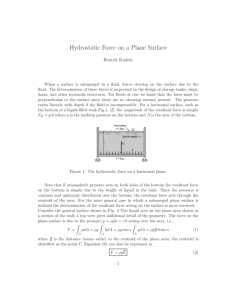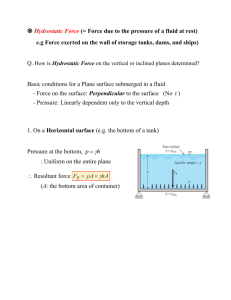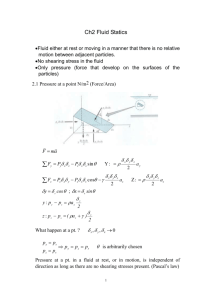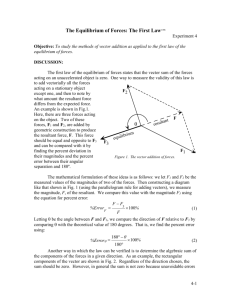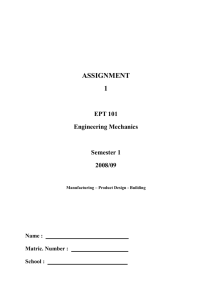Hydrostatic Force on a Plane Surface
advertisement
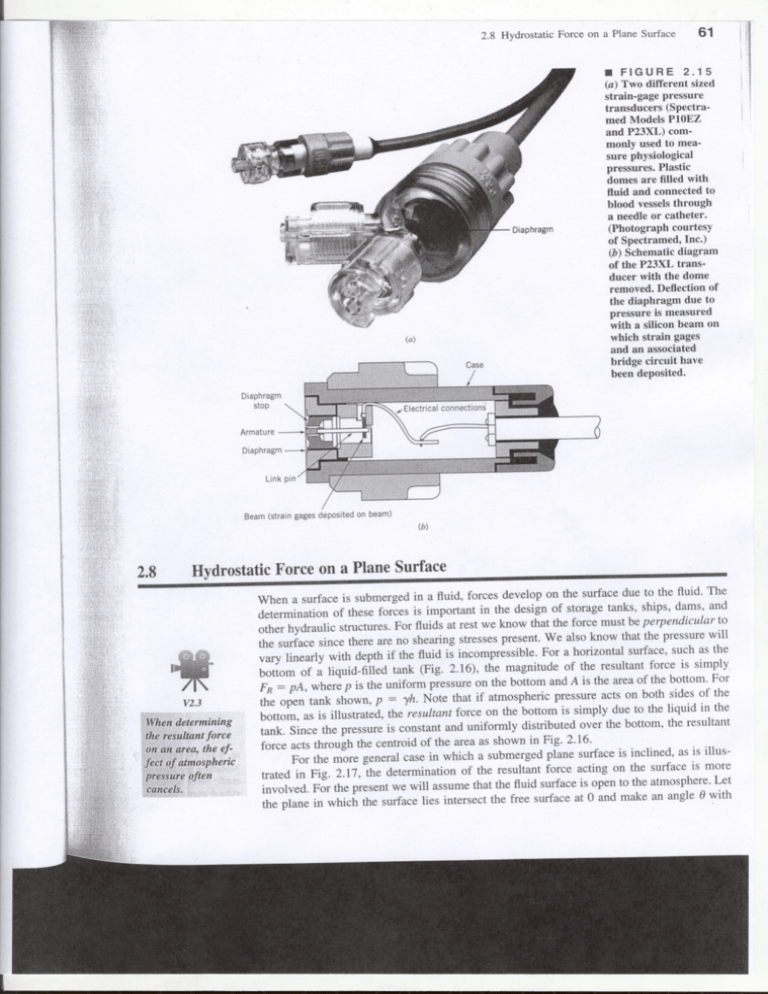
I
2.8 Hydrostatic Force on a Plane Surface
61
.
FIGURE
2.15
(a) Two different sized
strain-gage pressure
transducers (Spectramed Models PIOEZ
and P23XL) commonly used to measure physiological
pressures. Plastic
domes are filled with
fluid and connected to
blood vessels through
a needle or catheter.
(Photograph courtesy
of Spectramed, Inc.)
(b) Schematic diagram
of the P23XL transducer with the dome
removed. Deflection of
the diaphragm due to
pressure is measured
with a silicon beam on
which strain gages
and an associated
bridge circuit have
been deposited.
(a)
Diaphragm
stop
I
I
Beam (strain gages deposited on beam)
1
l
(b)
Hydrostatic Force on a Plane Surface
When a surface is submerged in a fluid, forces develop on the surface due to the fluid. The
determination of these forces is important in the design of storage tanks, ships, dams, and
other hydraulic structures. For fluids at rest we know that the force must be perpendicular to
the surface since there are no shearing stresses present. Wealso know that the pressure will
vary linearly with depth if the fluid is incompressible. For a horizontal surface, such as the
bottom of a liquid-filled tank (Fig. 2.16), the magnitude of the resultant force is simply
FR = pA, wherep is the uniformpressureon thebottomandA is the areaof thebottom.For
the open tank shown, p = yh. Note that if atmospheric pressure acts on both sides of the
bottom, as is illustrated, the resultant force on the bottom is simply due to the liquid in the
tank. Since the pressure is constant and uniformly distributed over the bottom, the resultant
force acts through the centroid of the area as shown in Fig. 2.16.
For the more general case in which a submerged plane surface is inclined, as is illustrated in Fig. 2.17, the determination of the resultant force acting on the surface is more
involved. For the present we will assume that the fluid surface is open to the atmosphere. Let
the plane in which the surface lies intersect the free surface at 0 and make an angle e with
I
62
Chapter 2 / Fluid Statics
i
.
FIG UR E 2. 1 6 Pressure and resultant
hydrostatic force developed on the bottom of an
open tank.
:!
~
j
i
j
3
i
i
this surface as in Fig. 2.17. The x-y coordinate system is defined so that 0 is the origin and y
is directed along the surface as shown. The area can have an arbitrary shape as shown. We
wish to determine the direction, location, and magnitude of the resultant force acting on one
side of this area due to the liquid in contact with the area. At any given depth, Ii, the force
acting on dA (the differential area of Fig. 2.17) is dF
=
'Yh dA and is perpendicular
to the
surface. Thus, the magnitude of the resultant force can be found by summing these differential
forces over the entire surface. In equation form
j
I
,1
,
f,
:i
i
I
!1
.~
:!
FR
=L
'YhdA
~
;
=)L 'YYsin e dA
j
j
]
where h = y sin e. For constant 'Yand e
j
~
(2.17)
FR = 'Ysin e L y dA
~
~
(
j
.'
!
I
t
.~
,,
,,
,,
.
x, ' '
XR
~
~"'/"/
/
/
//
Location of
resultant force
(center of pressure, CP)
FIGURE
2.17
Notation for hydrostatic force on an incIined~plane surface
of arbitrary shape.
I
-
-1
i
f
2.8 Hydrostatic Force on a Plane Surface
63
The integral appearing in Eq. 2.17 is the first moment of the area with respect to the x axis,
so we can write
L Y dA
=
YeA
where Yc is the Y coordinate of the centroid measured from the x axis which passes through O.
Equation 2.17 can thus be written as
=
FR
yAyc sin ()
or more simply as
I
FR
=
yhcA
(2.18)
I
where he is the vertical distance from the fluid surface to the centroid of the area. Note that
the magnitude of the force is independent of the angle () and depends only on the specific
weight of the fluid, the total area, and the depth of the centroid of the area below the surface.
In effect, Eq. 2.18 indicates that the magnitude of the resultant force is equal to the pressure
at the centroid of the area multiplied by the total area. Since all the differential forces that
were summed to obtain FR are perpendicular to the surface, the resultant FR must also be
perpendicular to the surface.
Although our intuition might suggest that the resultant force should pass through the
centroid of the area, this is not actually the case. The y coordinate, YR' of the resultant force
can be determined by summation of moments around the x axis. That is, the moment of the
resultant force must equal the moment of the distributed pressure force, or
FRYR=
L Y dF
=
LYSin
() y2 dA
and, therefore, since FR = yAy c sin ()
YR
=
L y2 dA
YeA
The integral in the numerator is the second moment of the area (moment of inertia), Ix, with
respect to an axis formed by the intersection of the plane containing the surface and the free
surface (x axis). Thus, we can write
YR =
Ix
-
YeA
Use can now be made of the parallel axis theorem to express Ix as
Ix
=
Ixc
+ Ay~
where Ixc is the second moment of the area with respect to an axis passing through its centroid
and parallel to the x axis. Thus,
- Ixc + Yc
YR - YeA
(2.19)
Equation 2.19 clearly shows that the resultant force does not pass through the centroid but is
always below it, since IxclYcA > O.
-
--~---~
64
~
---
--~
--
l
Chapter 2 / Fluid Statics
---
The x coordinate, XR' for the resultant force can be determined in a similar manner by
summing moments about the Y axis. Thus,
I
L
F~R =
sin 8 xy dA
'}'
and, therefore,
L xy
XR =
dA
=
YeA
[xy
YeA
where [xyis the product of inertia with respect to the x and Y axes. Again, using the parallel
axis theorem,l we can write
XR
A
=
(2.20)
[xye + xe
YeA
=ba
A =rrR2
Ix, = 112 ba3
{:
4
Ixc = lye = rrR4
I - 1 b3
ye
- I2a
Ixy,= 0
Ixy,= 0
(b)
(a)
A=-rrR2
2
A=ab
Ixc = 0.1O98R4
ba2
Ixye= n(b
2
I=ba3
xc 36
- 2d)
lye = 0.3927 R4
Ixy,= 0
(c)
(d)
1
I
4R
3rr
.
4R
13rr
A = rrR2
4
Ixc = lye = 0.05488R4
IXyc= -0.01647R4
(e)
FIGURE
2.18
Geometric properties of some common shapes.
]Recall that the parallel axis theorem for the product of inertia of an area states that the product of inertia with respect to an orthogonal
set of axes (x-y coordinate system) is equal to the product of inertia with respect to an orthogonal set of axes parallel to the original
set and passing through the centroid of the area, plus the product of the area and the x and y coordinates
Thus, Ixy = Ixy, + Axcy c'
of the centroid of the area.
I
I
-
---
-~
~
~~~
~~~~.-~---~-
--'-~---
-
2.8 Hydrostatic Force on a Plane Surface
by
65
where Ixye is the product of inertia with respect to an orthogonal coordinate system passing
through the centroia of the area and formed by a translation of the x-y coordinate system. If
the submerged area is symmetrical with respect to an axis passing through the centroid and
parallel to either the x or y axes, the resultant force must lie along the line x = xc' since Ixye
is identically zero in this case. The point through which the resultant force acts is called the
center of pressure. It is to be noted from Eqs. 2.19 and 2.20 that as Ye increases the center of
pressure moves closer to the centroid of the area. Since Ye = hclsin e, the distance Ye will
increase if the depth of submergence, he' increases, or, for a given depth, the area is rotated
so that the angle, e, decreases. Centroidal coordinates and moments of inertia for some common areas are given in Fig. 2.18.
.
leI
The 4-m-diameter circular gate of Fig E2.6a is located in the inclined wall of a large reservoir
~O)
containing water (y
=
9.80 kN/m3).
The gate is mounted on a shaft along its horizontal
diameter. For a water depth of 10 m above the shaft determine: (a) the magnitude and location
'of the resultant force exerted on the gate by the water, and (b) the moment that would have
to be applied to the shaft to open the gate.
0
0
/"x
/
I
;,Y
I
I
I
I
l
I
I
/
;'
~
0
°-
I
I
~/
1
{j
a0'
"'.$
vj)'
F,.,k
~~MOx
ow
(c1
~)
Centerof
pressure
(a)
. FIGURE E2.6
SOLUTION
(a) To find the magnitude of the force of the water we can apply Eq. 2.18,
FR = yheA
and since the vertical distance from the fluid surface to the centroid of the area is 10m
it follows that
FR
=
(9.80 X 103 N/m3)(10
= 1230
m)(41T m2)
X 103 N = 1.23 MN
(Ans)
To locate the point (center of pressure) through which FRacts, we use Eqs. 2.19
and 2.20,
al
aJ
a.
Ixye + Xc
XR = YeA
- Ixe + Ye
YR - YeA
I
~---~
66
~
~
~----
Chapter 2 / Fluid Statics
For the coordinate system shown, XR = 0 since the area is symmetrical, and the center
of pressure must lie along the diameter A-A. To obtain YR' we have from Fig. 2.18
nR4
I =-
4
xc
and Ye is shown in Fig. E2.6b. Thus,
(n/4)(2 m)4
Y =
R
(10 m/ sin 60°)(4n m2)
10 m
+-sin 60°
= 0.0866 m + 11.55 m = 11.6 m
and the distance (along the gate) below the shaft to the center of pressure is
YR - Ye = 0.0866 m
(Ans)
. We can conclude from this analysis that the force on the gate due to the water has a
magnitude of 1.23 MN and acts through a point along its diameter A-A at a distance of
0.0866 m (along the gate) below the shaft. The force is perpendicular to the gate surface
as shown.
(b) The moment required to open the gate can be obtained with the aid of the free-body
diagramof Fig. E2.6c.In this diagram"W is the weight of the gate and Ox and Oy are
the horizontal and vertical reactions of the shaft on the gate. We can now sum moments
about the shaft
2:
Me
=
0
and, therefore,
M = FR(YR - yJ
= (1230 X 103 N)(0.0866 m)
=
EXAMPLE
2.7
1.07 X 105 N.m
(Ans)
A large fish-holding tank contains seawater (y = 64.0 lb/ft3) to a depth of 10 ft as shown
in Fig. E2.7a. To repair some damage to one corner of the tank, a triangular section is replaced
with a new section as illustrated. Determine the magnitude and location of the force of the
seawater on this triangular area.
SOLUTION
The various distances needed to solve this problem are shown in Fig. E2.7b. Since the surface
of interest lies in a vertical plane, Ye = he = 9 ft, and from Eg. 2.18 the magnitude of the
force is
FR
= yheA
= (64.01b/ft3)(9ft)(9/2 ft2) = 2590 lb
(Ans)
2.8 Hydrostatic Force on a Plane Surface
67
:er
(a)
IS)
,a
of
ce
jy
Ire
Its
~
(b)
IS)
. FIGUREE2.7
(c)
Note that this force is independent of the tank length. The result is the same if the tank is
0.25 ft, 25 ft, or 25 miles long. The y coordinate of the center of pressure (CP) is found from
Eq.2.l9,
- Ixc + Ye
YR - YeA
and from Fig. 2.18
I
vn
~d
he
xc
=
=
(3 ft)(3 ft)3
36
~
f4
36 t
so that
81/36 ft4
y=
R
(9 ft)(9/2 ft2)
+9ft
= 0.0556 ft + 9 ft = 9.06 ft
Similarly, from Eq. 2.20
ce
he
XR
-
Ixyc
- YeA
+
Xc
and from Fig. 2.18
IS)
Ixye
=
(3 ft)(3 ft)2 (3 ft)
72
=
~
ft4
72
(Ans)
I
68
Chapter 2/ Fluid Statics
so that
81/72 ft4
XR
(Ans)
= (9 ft)(9/2 ft2) + 0 = 0.0278ft
Thus, we conclude that the center of pressure is 0.0278 ft to the right of and 0.0556 ft
below the centroid of the area. If this point is plotted, we find that it lies on the median line
for the area as illustrated in Fig. E2.7c. Since we can think of the total area as consisting of
a number of small rectangular strips of area 8A (and the fluid force on each of these small
areas acts through its center), it follows that the resultant of all these parallel forces must lie
along the median.
2.9
Pressure Prism
An informative and useful graphical interpretation can be made for the force developed by a
fluid acting on a plane area. Consider the pressure distribution along a vertical wall of a tank
of width b, which contains a liquid having a specific weight y. Since the pressure must vary
linearly with depth, we can represent the variation as is shown in Fig. 2.19a, where the
pressure is equal to zero at the upper surface and ,equal to yh at the bottom. It is apparent
from this diagram that the average pressure occurs at the depth h/2, and therefore the resultant
force acting on the rectangular area A = bh is
FR
The 'pressure prism
is a gl!°metric rep'lisen/ation of the
hydrostatic force on'
a plane surface. .
=
PavA
= Y (~) A
which is the same result as obtained from Eq. 2.18. The pressure distribution shown in Fig.
2.19a applies across the vertical surface so we can draw the three-dimensional representation
of the pressure distribution as shown in Fig. 2.19b. The base of this "volume" in pressurearea space is the plane surface of interest, and its altitude at each point is the pressure. This
volume is called the pressure prism, and it is clear that the magnitude of the resultant force
acting on the surface is equal to the volume of the pressure prism. Thus, for the prism of Fig.
2.19b the fluid force is
FR
=
volume = ~ (yh)(bh) = y
G) A
where bh is the area of the rectangular surface, A.
1
h
h
3
1
.
~yh~
(a)
(b)
FIGURE.2.19
Pressure prism for
vertical rectangular
area.
I
...
2.9 Pressure Prism
69
yhj
IS)
SMA
,ft
ne
of
all
lie
TIT
1
Yl
YA
21
E
(a)
(b)
.
FIGURE
2.20
Graphical representation of hydrostatic
forces on a vertical rectangular surface.
'a
[lk
ry
he
nt
nt
g.
m
eIS
;e
g.
The resultant force must pass through the centroid of the pressure prism. For the volume
under consideration the centroid is located along the vertical axis of symmetry of the surface,
and at a distance of hl3 above the base (since the centroid of a triangle is located at hl3
above its base). This result can readily be shown to be consistent with that obtained from
Eqs. 2.19 and 2.20.
This same graphical approach can be used for plane surfaces that do not extend up to
the fluid surface as illustrated in Fig. 2.20a. In this instance, the cross section of the pressure
prism is trapezoidal. However, the resultant force is still equal in magnitude to the volume
of the pressure prism, and it passes through the centroid of the volume. Specific values can
be obtained by decomposing the pressure prism into two parts, ABDE and BCD, as shown in
Fig. 2.20b. Thus,
FR = FI + F2
where the components can readily be determined by inspection for rectangular surfaces. The
location of FRcan be determined by summing moments about some convenient axis, such as
one passing through A. In this instance
FRyA
=
FIYI
+
F2Y2
and YI and Y2can be determined by inspection.
For inclined plane surfaces the pressure prism can still be developed, and the cross
section of the prism will generally be trapezoidal as is shown in Fig. 2.21. Although it is
usually convenient to measure distances along the inclined surface, the pressures developed
depend on the vertical distances as illustrated.
TI
h2
9
l .
FIG UR E 2. 2 1
Pressure variation
along an inclined plane area.
I
..
70
Chapter 2 / Fluid Statics
The use of pressure prisms for determining the force on submerged plane areas is
convenient if the area is rectangular so the volume and centroid can be easily determined.
However, for other nonrectangular shapes, integration would generally be needed to determine
the volume and centroid. In these circumstances it is more convenient to use the equations
developed in the previous section, in which the necessary integrations have been made and
the results presented in a convenient and compact form that is applicable to submerged plane
areasof any shape.
The res~ltant fluid
force acting on a
submerged area is
affecte~}Y ~hep~~ssure at the free surface.
.
The effect of atmospheric pressure on a submerged area has not yet been considered,
and we may ask how this pressure will influence the resultant force. If we again consider the
pressure distribution on a plane vertical wall, as is shown in Fig. 2.22a, the pressure varies
from zero at the surface to yh at the bottom. Since we are setting the surface pressure equal
to zero, we are using atmospheric pressure as our datum, and thus the pressure used in the
determination of the fluid force is gage pressure. If we wish to include atmospheric pressure,
the pressure distribution will be as is shown in Fig. 2.22b. We note that in this case the force
on one side of the wall now consists of FRas a result of the hydrostatic pressure distribution,
plus.the contribution of the atmospheric pressure, PatmA,where A is the area of the surface.
However, if we are going to include the effect of atmospheric pressure on one side of the
wall we must realize that this same pressure acts on the outside surface (assuming it is exposed
to the atmosphere), so that an equal and opposite force will be developed as illustrated in the
figure. Thus, we conclude that the resultant fluid force on the surface is that due only to the
gage pressure contribution of the liquid in contact with the surface-the atmospheric pressure
does not contribute to this resultant. Of course, if tne surface pressure of the liquid is different
from atmospheric pressure (such as might occur in a closed tank), the resultant force acting
on a submerged area, A, will be changed in magnitude from that caused simply by hydrostatic
pressure by an amount PsA, where Ps is the gage pressure at the liquid surface (the outside
surface is assumed to be exposed to atmospheric pressure).
Patm
T
h
Palm A
Patm A
.
1
f--rh--j
(a)
A pressurized tank contains oil (SG
EXAMPLE
2.8
Patm
(b)
=
FIGURE
2.22
Effect of atmospheric
pressure on the resultant force acting on a
plane vertical wall.
0.90) and has a square, 0.6-m by 0.6-m plate bolted
to its side, as is illustrated in Fig. E2.8a. When the pressure gage on the top of the tank reads
50 kPa, what is the magnitude and location of the resultant force on the attached plate? The
outside of the tank is at atmospheric pressure.
SOLUTION
The pressure distribution acting on the inside surface of the plate is shown in Fig. E2.8b. The
pressure at a given point on the plate is due to the air pressure, Ps' at the oil surface, and the
n
~:
...
I
I
2.9 Pressure Prism
71
IS
:d.
ae
as
1d
yhj
r-+-P,-1
/
1e
/
I
/
/
LOi I surface
/1
/
/
2m
'd,
1e
es
~
0.6 m
t
al
1e
'e,
~e
(a)
(b)
n,
e.
Ie
. FIG UR E E2. 8
~d
Ie
Ie
re
at
pressure due to the oil, which varies linearly with depth as is shown in the figure. The resultant
force on the plate (having an area A) is due to the components, FI and Fz, with
FI = (Ps + '}'hl)A
19
IC
= [50 X 103N/mz + (0.90)(9.81 X 103N/m3)(2 m)](0.36 mZ)
Ie
- 24.4 X 103N
and
Fz
=
'}' (
hz - hi
2
)A
= (0.90)(9.81X 103N/m3) (O.~ m) (0.36 mZ)
= 0.954 X 103N
The magnitude of the resultant force, FR, is therefore
2
c
1-
a
FR = FI + Fz = 25.4 X 103 N = 25.4 kN
(Ans)
The vertical location of FR can be obtained by summing mOments around an axis
through point 0 so that
FRyo = FI(0.3 m) + Fz(0.2 m)
or
d
s
e
~
= (24.4 X 103 N)(0.3 m) + (0.954 X 103 N)(0.2 m)
Yo = 0.296m
(25.4 X 103 N)yo
(Ans)
Thus, the force acts at a distance of 0.296 m above the bottom of the plate along the vertical
axis of symmetry.
Note that the air pressure used in the calculation of the force was gage pressure. Atmospheric pressure does not affect the resultant force (magnitude or location), since it acts
on both sides of the plate, thereby canceling its effect.
..
72
2.10
Chapter 2 / Fluid Statics
Hydrostatic Force on a Curved Surface
V2.4
The development of
a free-body diagram
of a suitable volume
of fluid can be used
to determine the resultant fluid force
acting on a curved
surface. '
The equations developed in Section 2.8 for the magnitude and location of the resultant force
acting on a submerged surface only apply to plane surfaces. However, many surfaces of
interest (such as those associated with dams, pipes, and tanks) are nonplanar. Although the
resultant fluid force can be determined by integration, as was done for the plane surfaces, this
is generally a rather tedious process and no simple, general formulas can be developed. As
an alternative approach we will consider the equilibrium of the fluid volume enclosed by the
curved surface of interest and the horizontal and vertical projections of this surface.
For example, consider the curved section BC of the open tank of Fig. 2.23a. We wish
to find the resultant fluid force acting on this section, which has a unit length perpendicular
to the plane of the paper. We first isolate a volume of fluid that is bounded by the surface of
interest, in this instance section BC, the horizontal plane surface AB, and the vertical plane
surface AC. The free-body diagram for this volume is shown in Fig. 2.23b. The magnitude
and location of forces Fl and F2can be determined from the relationships for planar surfaces.
The weight, OW,is simply the specific weight of the fluid times the enclosed volume and acts
through the center of gravity (CO) of the mass of fluid contained within the volume. The
forces FHand Fv represent the components of the force that the tank exerts on thefluid.
In order for this force system to be in equilibrium, the horizontal component FH must
be equal in magnitude and collinear with F2,and the vertical component Fvequal in magnitude
and collinear with the resultant of the vertical forces Fl and OW. This follows since the three
forces acting on the fluid mass (F2,the resultant of Fl and OW,and the resultant force that the
tank exerts on the mass) must form a concurrent force system. That is, from the principles
of statics, it is known that when a body is held in equilibrium by three nonparallel forces
they must be concurrent (their lines of action intersect at a common point), and coplanar.
Thus,
FH = F2
Fv = Fl + OW
and the magnitude of the resultant is obtained from the equation
FR
.__nn__n_nn------n_nnn_n_n
_--nnnnn.
=
+ (Fv)2
nnn
A
B
c
c
FIGURE
=v
(b)
(a)
II
Y(FH)2
2.23
Hydrostatic force on a curved surface.
(c)
2.10 Hydrostatic Force on a Curved Surface
'ce
of
he
l1S
<\s
he
sh
tar
of
ne
The resultant FR passes through the point 0, which can be located by summing moments
about an appropriate axis. The resultant force of the fluid acting on the curved surface BC is
equal and opposite in direction to that obtained from the free-body diagram of Fig. 2.23b.
The desired fluid force is shown in Fig. 2.23c.
The 6-ft-diameterdrainageconduitof Fig. E2.9ais half full of waterat rest. Determinethe
magnitude and line of action of the resultant force that the water exerts on a l-ft length of
the curved section BC of the conduit wall.
je
:s.
ts
1e
1.27 It
A
AH
1\-- - - - --
B
B
I FR= 523 Ib I
Fj
st
Ie
~e
Ie
~s
~s
r.
73
FH
32.5°~
1ft[:
c
(a)
(b)
III
FIGURE
(c)
E2.9
SOLUTION
We firstisolate a volumeof fluidboundedby the curvedsectionBC, the horizontalsurface
AB, and the vertical surface AC, as shown in Fig. E2.9b. The volume has a length of 1 ft.
The forces acting on the volume are the horizontal force, FI, which acts on the vertical surface
AC, the weight, W, of the fluid contained within the volume, and the horizontal and vertical
components of the force of the conduit wall on the fluid, FHand Fy, respectively.
The magnitude of FI is found from the equation
FI = ')!hcA = (62.4 lb/ft3)(!
ft)(3 ft2) = 28llb
and this force acts 1 ft above C as shown. The weight, W, is
W = ')!vol = (62.4 lb/ft3)(97T/4 ft2)(l ft) = 44llb
and acts through the center of gravity of the mass of fluid, which according to Fig. 2.18 is
located 1.27 ft to the right of AC as shown. Therefore, to satisfy equilibrium
FH
=
FI
= 281 lb
Fy = W = 441 lb
and the magnitude of the resultant force is
FR
= V(FH? + (Fy)2
= V(28l lb? + (441 lb)2 = 523 lb
(Ans)
The force the water exerts on the conduit wall is equal, but opposite in direction, to the forces
FH and Fy shown in Fig. E2.9b. Thus, the resultant force on the conduit wall is shown in Fig.
E2.9c. This force acts through the point o at the angle shown.
,
74
Chapter 2 / Fluid Statics
An inspection of this result will show that the line of action of the resultant force passes
through the center of the conduit. In retrospect, this is not a surprising result since at each
point on the curved surface of the conduit the elemental force due to the pressUreis normal
to the surface, and each line of action must pass through the center of the conduit. It therefore
follows that the resultant of this concurrent force system must also pass through the center
of concurrence of the elemental forces that make up the system.
This same general approach can also be used for determining the force on curved
surfaces of pressurized, closed tanks. If these tanks contain a gas, the weight of the gas is
usually negligible in comparison with the forces developed by the pressure. Thus, the forces
(such as FJ and F2 in Fig. 2.23b) on horizontal and vertical projections ofthe curved surface
of interest can simply be expressed as the internal pressure times the appropriate projected
area.
2.11
Buoyancy, Flotation, and Stability
2.11.1
The resultant fluid
force acting on a
body that is completely submerged
or floating 'in a
fluid is called the
buoyant force.
Archimedes' Principle
When a body is completely submerged in a fluid, or floating so that it is only partially
submerged, the resultant fluid force acting on the body is called the buoyant force. A net
upward vertical force results because pressure increases with depth and the pressure forces
acting from below are larger than the pressure forces acting from above. This force can be
determined through an approach similar to that used in the previous article for forces on
curved surfaces. Consider a body of arbitrary shape, having a volume ¥, that is immersed
in a fluid as illustrated in Fig. 2.24a. We enclose the body in a parallelepiped and draw a
free-body diagram of the parallelepiped with the body removed as shown in Fig. 2.24b. Note
that the forces FJ, F2' F3, and F4 are simply the forces exerted on the plane surfaces of the
parallelepiped (for simplicity the forces in the x direction are not shown), "Wis the weight of
the shaded fluid volume (parallelepiped minus body), and FBis the force the body is exerting
on the fluid. The forces on the vertical surfaces, such as F3 and F4, are all equal and cancel,
so the equilibrium equation of interest is in the z direction and can be expressed as
FB
=
F2
-
FJ -
"W
(2.21)
If the specific weight of the fluid is constant, then
F2 - FJ = y(h2 - hdA
where A is the horizontal area of the upper (or lower) surface of the parallelepiped, and Eq.
2.21 can be written as
FB
=
y(h2
-
hJ)A - y[(h2 - hJ)A - ¥]
Simplifying, we arrive at the desired expression for the buoyant force
I
V2.5
FB
=
y¥
(2.22)
I
where y is the specific weight of the fluid and ¥ is the volume of the body. The direction
of the buoyant force, which is the force of the fluid on the body, is opposite to that shown
on the free-body diagram. Therefore, the buoyant force has a magnitude equal to the weight
